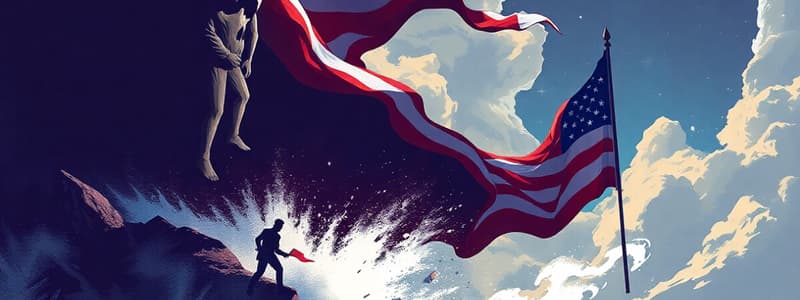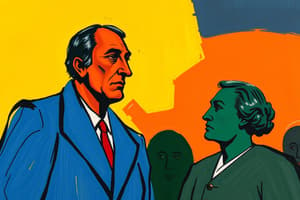Podcast
Questions and Answers
What specific historical event prompted the United States to abandon its initial policy of neutrality and enter World War I in 1917?
What specific historical event prompted the United States to abandon its initial policy of neutrality and enter World War I in 1917?
Germany's resumption of unrestricted submarine warfare and the Zimmerman Telegram.
What was the primary objective of the Espionage Act of 1917, and how did it impact civil liberties during World War I?
What was the primary objective of the Espionage Act of 1917, and how did it impact civil liberties during World War I?
To prevent criticism of the government and actions against the war effort, limiting freedom of speech.
Describe the actions taken by Charles Schenck that led to his arrest and subsequent legal battle.
Describe the actions taken by Charles Schenck that led to his arrest and subsequent legal battle.
Schenck printed and distributed leaflets encouraging draftees to peacefully resist the draft.
Summarize the main argument presented by Charles Schenck in his appeal to the Supreme Court.
Summarize the main argument presented by Charles Schenck in his appeal to the Supreme Court.
What was the central legal question that the Supreme Court sought to address in Schenck v. United States?
What was the central legal question that the Supreme Court sought to address in Schenck v. United States?
Explain the 'clear and present danger' test articulated by Justice Oliver Wendell Holmes in the Schenck decision.
Explain the 'clear and present danger' test articulated by Justice Oliver Wendell Holmes in the Schenck decision.
In your own words, what analogy did the Supreme Court use to justify its decision in Schenck v. United States?
In your own words, what analogy did the Supreme Court use to justify its decision in Schenck v. United States?
How did the Supreme Court's ruling in Schenck v. United States broaden the understanding of First Amendment protections?
How did the Supreme Court's ruling in Schenck v. United States broaden the understanding of First Amendment protections?
What distinguishes the 'clear and imminent danger' test established in Brandenburg v. Ohio from the 'clear and present danger' test used in Schenck v. United States?
What distinguishes the 'clear and imminent danger' test established in Brandenburg v. Ohio from the 'clear and present danger' test used in Schenck v. United States?
What was the relationship between Charles Schenck and the Socialist Party of America?
What was the relationship between Charles Schenck and the Socialist Party of America?
What specific amendment did Schenck cite in his leaflets as part of his argument against the draft?
What specific amendment did Schenck cite in his leaflets as part of his argument against the draft?
How many people were imprisoned for violating the Espionage Act?
How many people were imprisoned for violating the Espionage Act?
True or false: initially, the First Amendment was interpreted to protect only against actions of the press.
True or false: initially, the First Amendment was interpreted to protect only against actions of the press.
What test was used initially which would allow speech to be restricted if it had a tendency to lead to conduct the government had a right to prevent?
What test was used initially which would allow speech to be restricted if it had a tendency to lead to conduct the government had a right to prevent?
What is the name of the Supreme Court case that established the 'clear and imminent danger' test?
What is the name of the Supreme Court case that established the 'clear and imminent danger' test?
Flashcards
Selective Service Act of 1917
Selective Service Act of 1917
Law requiring men ages 21-30 to register for military service in 1917.
Espionage Act of 1917
Espionage Act of 1917
Law aimed to prevent criticism of the government and actions against the war effort.
Charles Schenck
Charles Schenck
General Secretary of the Socialist Party who opposed U.S. involvement in World War I.
Schenck v. United States
Schenck v. United States
Signup and view all the flashcards
"Clear and Present Danger" Test
"Clear and Present Danger" Test
Signup and view all the flashcards
"Bad Tendency Test"
"Bad Tendency Test"
Signup and view all the flashcards
"Clear and Present Danger" Test
"Clear and Present Danger" Test
Signup and view all the flashcards
"Clear and Imminent Danger" Test
"Clear and Imminent Danger" Test
Signup and view all the flashcards
Schenck's Leaflets
Schenck's Leaflets
Signup and view all the flashcards
Supreme Court Decision
Supreme Court Decision
Signup and view all the flashcards
Significance of Schenck v. United States
Significance of Schenck v. United States
Signup and view all the flashcards
Espionage Act Criminalization
Espionage Act Criminalization
Signup and view all the flashcards
Zimmerman Telegram
Zimmerman Telegram
Signup and view all the flashcards
Study Notes
Context of the Case
- Early 1917 marked the height of World War I in Europe.
- The U.S. initially remained neutral but leaned towards the Allied Forces.
- Germany's unrestricted submarine warfare and the Zimmerman Telegram (proposing a German-Mexican alliance against the U.S.) prompted President Wilson to seek a war declaration.
- On April 6, 1917, the U.S. declared war on Germany, entering World War I.
Legislation
- The Selective Service Act of 1917 required men aged 21-30 to register for military service; this was later expanded to include men aged 18-45.
- The Espionage Act of 1917 aimed to prevent criticism of the government and actions against the war effort, with punishments up to 20 years in prison.
- The Espionage Act criminalized speech or actions that obstructed or discouraged military recruiting.
- Over 2,000 people were imprisoned for violating the Espionage Act.
Charles Schenck and the Socialist Party
- Charles Schenck, General Secretary of the Socialist Party of America, opposed U.S. involvement in World War I.
- Schenck printed and distributed 15,000 leaflets to encourage draftees to peacefully resist the draft.
- The leaflets cited the 13th Amendment and urged petitioning the government for change.
- Schenck's leaflets aimed to disrupt the draft but did not advocate violence or disobeying the Selective Service Act.
Legal Proceedings
- Schenck was arrested and charged with violating the Espionage Act of 1917.
- The district court found Schenck guilty and dismissed his First Amendment concerns.
- Initially, the First Amendment was interpreted to only protect against prior restraints on publication.
- The "bad tendency test" was applied, allowing speech restriction if it tended to cause conduct the government could rightfully prevent.
Schenck vs. United States
- Charles Schenck appealed his case to the U.S. Supreme Court.
- The Supreme Court agreed to hear arguments on whether Schenck's leaflet distribution was protected under the First Amendment rights of speech and press.
- Schenck argued the Espionage Act violated the First Amendment by suppressing opposition to the draft when advocated through legal means.
- The government argued that ensuring successful war prosecution was a legitimate exercise of war power.
Supreme Court Decision
- The Supreme Court unanimously upheld Schenck's conviction, deciding the Espionage Act did not violate the First Amendment.
- Justice Oliver Wendell Holmes authored the opinion, introducing the "clear and present danger" test.
- The Court reasoned that the leaflets, while harmless in peacetime, could be destructive during wartime by potentially interfering with military objectives.
- The Court likened Schenck's actions to "falsely shouting fire in a theater and causing a panic."
- The Court determined that Congress could suppress speech posing a "clear and present danger" to legitimate government goals such as prosecuting a war.
Significance and Impact
- Schenck v. United States was the first time the Supreme Court authoritatively stated that First Amendment protections extended beyond limiting prior restraints.
- The "clear and present danger" test was established to evaluate seditious speech, but it was not applicable to cases involving defamation, obscenity, or commercial speech
- The clear and present danger test was used for nearly 50 years.
- In 1969, the Supreme Court case Brandenburg vs. Ohio established the "clear and imminent danger" test.
- The "clear and imminent danger" test protects more speech by requiring an immediate danger.
- The version of the "clear and present danger" test applied in Schenck v United States no longer exists as a matter of law.
Studying That Suits You
Use AI to generate personalized quizzes and flashcards to suit your learning preferences.




